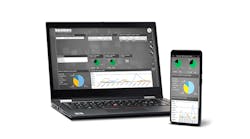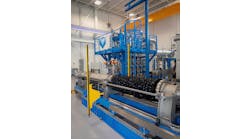“Ask the Experts” is moderated by Béla Lipták, consultant and editor of the Instrument Engineer’s Handbook (IEH). He’s starting work on the 5th edition and requires three experienced colleagues to act as co-editors. If you’re interested or if you’d like to ask a question or join our team of experts, who answer the questions, write to [email protected].
Q: Can any one give me a simple formula for changing volume flow steam into mass flow steam? Our steam is superheated, and we have pressure and temperature recording.
G. Williams
[email protected]
Kimberly-Clark Limited
A: You can find the superheated steam tables in Appendix A.5b (on page 1,353) in Volume 1 of my Instrument Engineers’ Handbook.
BÉLA LIPTÁK
[email protected]
A: When automating the conversion of volumetric dry steam flow to mass flow using pressure and temperature parameters, we use the gas laws. The gas law applies to superheated and dry steam over extended regions of pressure and temperature. It becomes the basis for making the conversion from volumetric to mass flow.
The value of the applicable gas constant can be derived from steam tables or charts for the pressure and temperature region of interest by picking one point in the center of the operating domain, and noting the values of v, P and T. Using this set of values, the gas constant, R = v * P/T, where v = specific volume of dry steam in volume per mass units; P = absolute pressure in force per unit area units; and T is the temperature in absolute temperature units.
Mass flow rate, m = V * P / ( R * T) where V = measured volumetric flow rate in volume per time units; P = measured dry steam pressure in absolute pressure units; R is the above derived gas constant in units compatible with the measurements; and T is the measured dry steam temperature in absolute temperature units. The pressure and temperature measurements may not be in absolute units. In that case, add the barometric pressure (in compatible units) to the measured gauge pressure, and 273 (in the case of a degree Centigrade or 460 in the case of a degree Fahrenheit measurement) to the measured value before the above-indicated computation is completed.
Any set of units that can be related to the steam table or steam chart in your library can be used.
By way of example, I will assume your steam temperature is 610 °F (610 + 460 = 1070 °R); your pressure is 86.0 psig; and your barometric pressure is 14.5 psia (86.0 + 14.5 = 100.5 psia steam pressure); your measured flow rate is 2.34 cu ft per second. You may ask, what is the flow rate in pounds of steam per second.
My steam table has no entry for 610 °F and 100.5 psia, but there is an entry for 600 °F and 100 psia. For that combination, the table shows the specific volume, v = 6.216 cu ft/lb. Using that data, gas constant R = v * P/T = 6.216 * 100/(600 + 460) = 0.5864 (cu ft/(sq.in.* °R)). With the gas constant, R, in hand, the mass rate m for your measured conditions may now be found: m = V * P / ( R * T) = 2.34 cu ft/sec * 100.5 psia /(0.5864*1070 °R) = 0.3784 lb/sec.
If the conditions change, and the volumetric flow rises to 10 cu ft/sec, while the pressure becomes 95 psig, and the temperature falls to 590 °F, then the mass flow rate becomes m = V * P / ( R * T) = 10 * (95 + 14.5)/(0.5864*(590 + 460)) = 10*109.5/(0.5864*1030) = 1.813 lb/sec. (Note the reuse of the gasconstant, R, derived at the beginning.)
Barometric pressure changes, as a fraction of the total process pressure, are small, and the barometric pressure used in calculations of this kind may be taken to be the average annual barometric pressure for the process location.
Steam tables are available for other units of measurement, such as pressure in bar, temperature in degrees Kelvin and specific volume in cu m/kg. Use the table that comes closest to matching your measurement units and use conversion constants for the misfits.
Otto Muller-Girard, PE, FISA
Q: What is the basis for fixing the acceptance criteria for an equipment under calibration?
Sunil Mathew
SFO TECHNOLOGIES
[email protected]
A: During calibration, we ascertain the error by comparing the sensor output against a reference. (I intentionally use the term “error” instead of “accuracy” because I prefer the grammatically correct term, since a device is 1% accurate when it has 99% error.)
Otherwise, there are no “universal” criteria for calibration. As to the allowable maximum error, that is a function of the application. Personally, I like to use a reference that has an order of magnitude smaller error than the device being calibrated.
If you are a manufacturer of a device, you should inform the user of the maximum error that you guarantee not to succeed, namely the error as a percentage of the actual measurement. In addition, you should also state the rangeability over which the guaranteed error statement is guaranteed.
In addition, if the error limit is influenced by process- or installation-related factors (Reynolds number, straight pipe run requirement, viscosity limit, etc.), you should also state those limitations. For example, for a magnetic flow meter, you might say that the error limit (inaccuracy) is 1% of actual flow within the range of 10:1 if the process fluid is conductive and the flow velocity exceeds 0.5 fps.
Béla Lipták
A: The criterion for calibration acceptance is that “the instrument under calibration meet the manufacturer’s advertised specifications.” Calibration has nothing to do with the absolute accuracy of a device.
Standard procedure is that if a unit under calibration fails to meet the advertised specification in a single area, then it may be marked “limited use only,” and the limit must be specified. For instance, if a multimeter were found to be out of calibration on the 1 V scale, it could be marked “Limited use only. 1 V scale out of tolerance.” Consequently, it could then be used on the 10 V scale. Ideally, any unit out of calibration on any scale would be removed from service until it was fully functional.
The accepted calibration procedure requires that the standard have an accuracy that is 10 times better than the device under test. For instance, a pressure transducer with an accuracy of 0.01% would, therefore, require a standard of 0.001%.
This may be easy to achieve with a 100-psi pressure transducer and a dead-weight tester. At the extreme end of sensitivity of some modern devices, this is no longer possible. For instance, calibration of 1 in. of a water column pressure transducer is difficult. In these cases, a ratio of 1 to 4 is accepted. However, there’s no case in which a ratio of worse than 1 to 4 acceptable.
Bruce Land
Johns Hopkins University
Applied Physics Laboratory
Q: How do I calibrate a DP transmitter for use on a boiler drum? We’re using the wet leg measurement directly from the high and low measurement points on the drum to the DP transmitter.
Tom Parker
[email protected].
A: The DP cell detects the weight of the column inside the drum between the two taps. This weight drops as temperature rises because of the swelling effect, and usually drops as the pressure rises, because steam bubbles are compressed. I said “usually” because the weight of steam per unit volume increases. Therefore, if you’re interested in the mass of water and steam in the drum, the DP cell will give you that information, but if you want to know if the top of the boiling liquid level has reached some maximum point, DP detection will not do. For that you can use a conductivty probe.
Béla Lipták
A: The pressure seen by the LP leg will be that due to a head of cold water matching the height of the LP leg, plus the drum pressure.
The pressure seen by the HP leg will be due to a leg of cold water (height of lower tapping to DP transmitter) plus a leg of hot water corresponding to the height in the drum (density very much lower, a function of drum pressure) plus a leg of steam (density a function of pressure, very significant in comparison with water density), plus the drum pressure.
So the “effective” density of the hot leg is the density of the water minus the density of the steam. For a drum level measurement to work from start-up to online requires a continuous knowledge of the density, and this will be changing with pressure/temperature.
The other twist is, of course, “what do you call level?” The liquid in the drum swells and shrinks depending on the vapor fraction in the particular cross section that you are measuring. A DP measurement is a measurement of the mass of a column of liquid + vapor adjacent to the tapping point. A boiler drum is not an equilibrium device. So it is quite easy for the top of the denser phase (liquid) to be elevated by a number of bubbles of the lower density (vapor) phase interspersed. A DP transmitter, by its very nature, can’t tell where the top of the liquid phase is, just where it would be if there were no bubbles in it.
Ian H. Gibson
Engineering Consultant
Process, Control and Safety Systems




